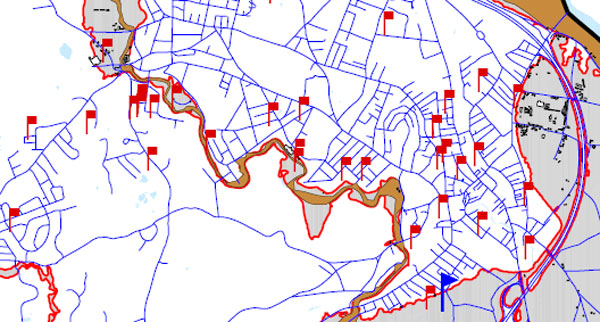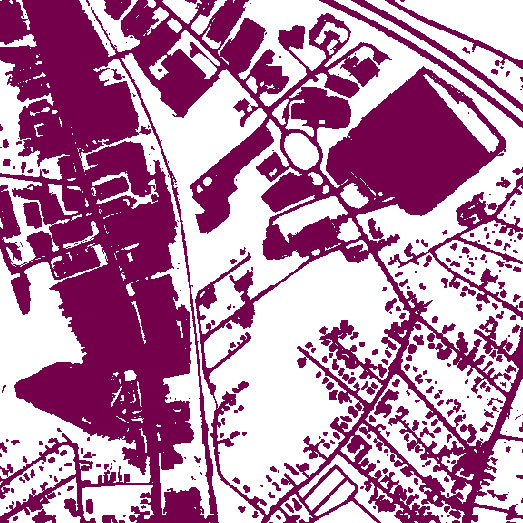This afternoon’s thunderstorm pressured Northampton’s downtown storm drains. Police closed the North Street underpass after a car began floating and had to be pushed out. Photos by Adam Cohen.



Water at the corner of Hampton Avenue and Old South Street overran the sidewalk…

State Street approaching Summer Street…


See also:
Flooding Incidents in the North Street Neighborhood: 2003-2007
…6/23/03: North Street
Respond above location vehicle stuck in rising water in underpass…
10/8/05: North Street
…multiple calls for flooding under trestle… black dodge avenger stuck in water under trestle… Report of street flooded…
Video: Chamber Presents “Rezoning King Street” to Planning Board (6/13/10)
[Click the above link for] excerpts from the Chamber’s “Findings & Recommendations” (PDF). The attention to parking issues and pedestrian comfort is welcome. Potential areas of controversy include:
- Allowing more uses without a Special Permit, including hotels. A recent proposal to build a Hilton Garden Inn downtown was extremely controversial. One way to address the public’s desire for good design would be robust infill design standards.
- Reducing the setbacks between commercial areas and residential neighborhoods
- Stormwater management problems caused by an increase in impervious surface
March 10: Zoning Revisions Committee to Meet; Our Suggestions
How will proposed rule changes affect the quality of life within in-town districts? Changes that erode amenities (e.g. greenspace), raise safety issues (e.g. more flooding) or create hassles (e.g. more traffic jams) may defeat the purpose of the Sustainable Northampton Plan by motivating homebuyers to sprawl out elsewhere.
Northampton’s Flood and Natural Hazard Mitigation Plan: Floyd Flood Damage Reported Behind View Avenue; Avoid Building on Filled Wetlands
…In general, a core problem for infill in Northampton is to avoid placing large numbers of people and structures in low-lying areas downtown that may be at risk for flooding. As the plan states, “In recent years, heavy rainstorms have caused significant problems in more urbanized areas as increased development inhibits proper drainage and existing or poorly maintained water systems cannot handle increased stormwater runoff.”
[Flood damage reports from Tropical Storm Floyd pepper downtown Northampton (1999). Note most of the red flags are outside the traditional 100-year floodplain. This is a sign that Northampton’s stormwater management systems are stretched even under the existing wetlands buffer zone regime. We object to ratcheting up the pressure on our in-town wetlands, a key part of our natural drainage system.]

Topographical Map Shows How Kohl Condo Proposal Will Eat Into a Rare Stand of Mature Trees in Downtown
The following view dramatizes the considerable amount of impervious surface already in the area, especially around King Street and the Coca-Cola plant. Kohl’s “infill” project will convert a significant amount of the remaining greenspace to impervious surface. The presence of Millyard Brook shows that this area serves as a natural sink for water in the neighborhood.

Gazette: “Region’s storms going to extremes, report finds” (12/5/07)
Springfield Republican: “Northeast seeing more, fiercer rainstorms in line with global warming predictions, study says” (4/5/10)
Healthy wetlands and wetlands buffers mitigate flooding. Compared to manmade stormwater infrastructure, wetlands are cheap, effective, and low-maintenance forms of flood control. Scientific studies suggest wetlands need 50-foot buffers or more to retard degradation from human activity.
Christian Science Monitor: “How to plan better for New England floods” (4/19/10)
As Hurricane Threat Builds, Has Complacency Set In about Flooding? (8/4/07)
Joe Bastardi, Chief Forecaster of the AccuWeather.com Hurricane Center: “New England is fair game from now on until 2025, although the most frequent threats to the Northeast should be later in the run of the cycle.”
…Infill sounds great on paper, but when it means paving over green space in downtown Northampton, it runs contrary to sound flood mitigation practice. The reality is that much of the remaining green space in downtown is in low-lying areas that are most susceptible to flooding. It makes sense to go along with the collective wisdom of the past 350 years and leave them undeveloped.
Comparing the New Hazards Mitigation Plan to the Old One: Wetlands Protection Weakened (11/2/08)
[The new Hazards Mitigation Plan states:] “The last hurricane to make landfall in New England was Hurricane Floyd, a weak category 2 hurricane, in November 1999. Therefore, it is forecasted that, Massachusetts, and the rest of New England, is long overdue for a major hurricane to make landfall. Based on past hurricane and tropical storm landfalls, the frequency of tropical systems to hit the Massachusetts coastline is an average of once out of every six years.” (p.28, emphasis added)